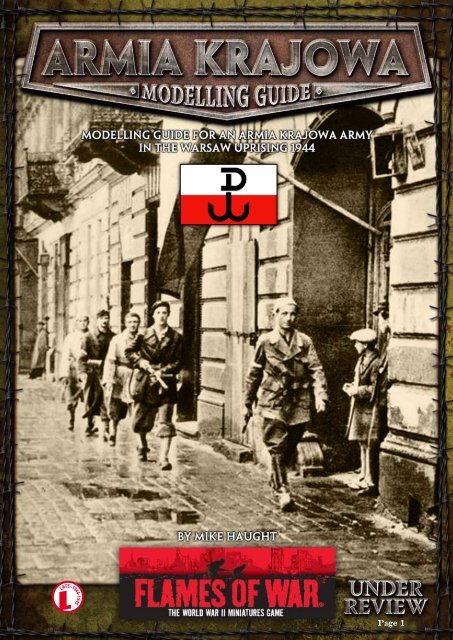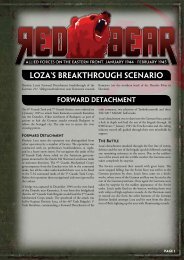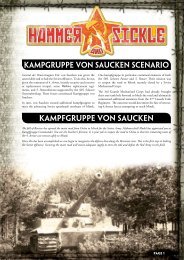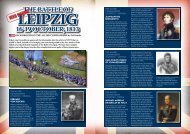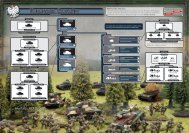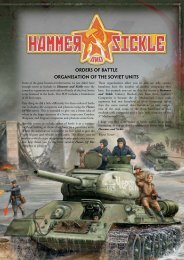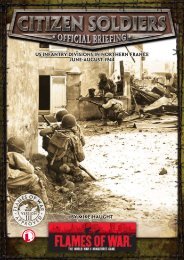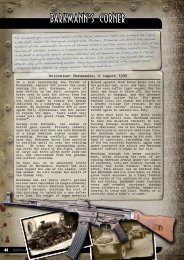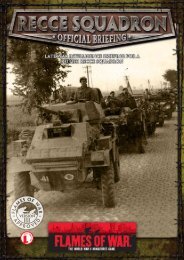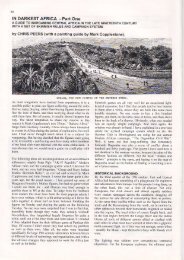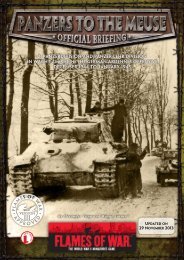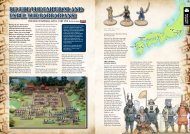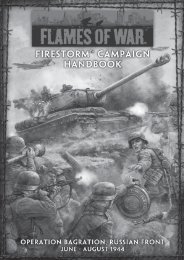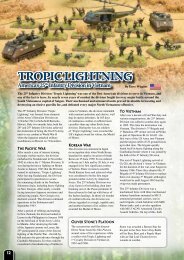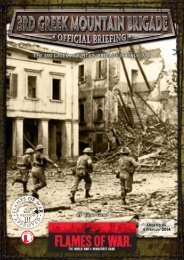Modelling Your Armiya Krajowa PDF... - Flames of War
Modelling Your Armiya Krajowa PDF... - Flames of War
Modelling Your Armiya Krajowa PDF... - Flames of War
You also want an ePaper? Increase the reach of your titles
YUMPU automatically turns print PDFs into web optimized ePapers that Google loves.
Page
RESEARCHING THE ARMIA KRAJOWA<br />
One <strong>of</strong> the most remarkable things to come out <strong>of</strong> the<br />
<strong>War</strong>saw Uprising was the sheer number <strong>of</strong> photographs and<br />
films taken by the Polish insurgants themselves. It is even<br />
more amazing that these managed to survive to provide us<br />
with an intimate view <strong>of</strong> the battles that were fought.<br />
Several civilians took it upon themselves to document the<br />
uprising through photography. They risked their lives to take<br />
many <strong>of</strong> dramatic and telling photos. After the uprising the<br />
Germans, and later the Soviets, actively pursued these photos<br />
and destroyed as many as they could find. Photographers<br />
began hiding their negatives to protect them. As time wore<br />
on and <strong>War</strong>saw was rebuilt many <strong>of</strong> these photos were lost.<br />
However, now and again a stash <strong>of</strong> negatives and photos are<br />
uncovered which tell new stories <strong>of</strong> the Uprising.<br />
Its through the lens <strong>of</strong> the brave civilian photographer that<br />
we can see the Uprising unfold. Pictures <strong>of</strong> soldiers, terrain<br />
and equipment help us remember the sacrifices <strong>of</strong> the Polish<br />
people during the summer <strong>of</strong> 1944.<br />
I’ve dedicated this section to showcase the source material<br />
available on the <strong>War</strong>saw Uprising, including some interesting<br />
photos. These highlight the wide variety <strong>of</strong> people and<br />
equipment that fought. Hopefully, you will find these photos<br />
helpful when you start you own Armyia <strong>Krajowa</strong> force for<br />
<strong>Flames</strong> Of <strong>War</strong>.<br />
I’ve also included a bibliography <strong>of</strong> sources that I found<br />
useful when researching the <strong>War</strong>saw Uprising so that you<br />
can begin your own research into this historic event.<br />
<strong>War</strong>saw Uprising Bibliography<br />
Books:<br />
Davies, Norman. Rising ‘44: The Battle for <strong>War</strong>saw. Penguin<br />
Publishing, 2005.<br />
Forczyk, Robert. <strong>War</strong>saw 1944: Poland’s bid for freedom.<br />
Osprey Publishing, 2009.<br />
Mountfield, David. The Partisans: Secret Armies <strong>of</strong> World<br />
<strong>War</strong> II. Hamlyn Publishing, 1979.<br />
Magazines:<br />
After the Battle, The <strong>War</strong>saw Uprising. Issue 143 (2009).<br />
Websites (active as <strong>of</strong> 2009):<br />
European Resistance Archive<br />
(Interviews with resistance members across Europe)<br />
http://www.resistance-archive.org/<br />
Poland on the Web<br />
(Essays on the <strong>War</strong>saw Uprising)<br />
http://www.info-poland.buffalo.edu/web/history/WWII/<br />
powstanie/link.shtml<br />
<strong>War</strong>sawUprising.com<br />
(General History <strong>of</strong> the Uprising)<br />
http://www.warsawuprising.com<br />
Muzeum Powstania <strong>War</strong>szawskiego<br />
(Museum <strong>of</strong> the <strong>War</strong>saw Uprising)<br />
http://www.1944.pl/<br />
Above: These Polish soldiers demonstrate the variety in uniforms that the<br />
AK employed. They are wearing Waffen-SS camo smocks with non-SS<br />
trousers, most likely <strong>of</strong> old Polish army issue. They are also wearing both<br />
jack and low boots.<br />
Above: More than 4,000 women fought in the <strong>War</strong>saw Uprising. Initially,<br />
they served in support roles such as this dispatch runner. However, as the<br />
rebellion progressed they began to take up arms along side the men and<br />
fight. After the uprising, over 2000 women soldiers marched into captivity.,<br />
having proudly served the cause.<br />
Page
Above: This photograph demonstrates further diversity in Polish AK uniforms and equipment. The solider to the left and right appears to be wearing<br />
German fieldgrey Panzer style jackets, while the one on the right has found a Waffen-SS smock.<br />
Also <strong>of</strong> note are their helmets. The man just right <strong>of</strong> the woman is wearing an Polish wz.31 helmet and the others have standard German helmets with<br />
Waffen-SS helmet covers.<br />
Above: AK troops don their new Waffen-SS uniforms.<br />
Page
Above: An AK-controlled 5cm PaK38 anti-tank gun. The crew is wearing full SS uniforms including trousers, boots, s<strong>of</strong>t caps, and jacket. The gun itself<br />
appears to have been left in its original camouflage.<br />
Above: This heavy weapons squad is taking a break between missions. Again you can see the difference in the sorts <strong>of</strong> uniforms worn by AK soldiers. Their<br />
trousers and shirts are various colours and most likely a mix <strong>of</strong> civilian and military issue.<br />
They have also white eagles painted in white. The eagle insignia is based upon the Polish coat <strong>of</strong> arms. They have been painted very large to help in identification<br />
and provide an interesting painting opportunity.<br />
Page
MODEL CHECKLIST FOR AN AK ARMY<br />
Building an AK army can be challenging and one <strong>of</strong> the most<br />
difficult tasks is sorting out which models you need for your<br />
army. Below is a list <strong>of</strong> models you can use for your army sorted<br />
out by infantry, gun and vehicle teams.<br />
The AK’s variety <strong>of</strong> equipment <strong>of</strong>fers great modelling potential.<br />
For example, their heavy machine guns varied from Maksim<br />
guns to captured German ones. So modelling your heavy<br />
machine-gun platoon with both examples would help replicate<br />
the hodge-podge nature <strong>of</strong> AK equipment.<br />
Infantry platoons also <strong>of</strong>fer excellent modelling opportunities<br />
where you can pull figures from a great deal <strong>of</strong> sources for your<br />
teams. You can be as creative as you like building an AK army!<br />
Infantry<br />
Polish Unit Model to Use Original Nationality Product Code<br />
AK and Kedyw<br />
infantry & gun teams<br />
SS-Panzergrenadierkompanie German GBX18<br />
AK and Kedyw<br />
infantry teams<br />
SS-Panzergrenadier Platoon (Mid) German GE791<br />
AK mortar teams SS-Mortar Platoon (Late) German GE815<br />
AK, Kedyw, and<br />
Polish Strelkovy<br />
Battle Hardened Strelkovy Platoon Soviet SU802<br />
infantry teams<br />
AK infantry Partisans & Polizei Soviet SBX09<br />
AK and Kedyw Flame-Thrower Platoon (late) Soviet SU737<br />
flame-thrower teams<br />
Gun teams<br />
Polish Unit Model to Use Original Nationality Product Code<br />
AK machine-gun teams Machine-Gun Company (late) Soviet SU734<br />
AK anti-tank gun teams 3.7cm PaK36 gun (x2) German GE501<br />
AK anti-tank gun teams 5cm PaK38 gun (x2) German GE510<br />
AK Artillery Battery Artillery Battery German GBX13<br />
AK Artillery Battery 10.5cm leFH18 howitzer (x2) (Late) German GE572<br />
Polish Strelkovy Company 45mm obr 1937 gun (x2) Soviet SU500<br />
Polish Strelkovy Company Mortar Company (late) Soviet SU735<br />
Polish Strelkovy Company Anti-tank Rifle Platoon (late) Soviet SU738<br />
Vehicles<br />
Polish Unit Model to Use Original Nationality Product Code<br />
Kedyw Assault Platoon Panzergrenadier Company HQ German GBX17<br />
Kedyw Tank Platoon Ernst Barkmann German GBX21<br />
Kedyw Tank Platoon Panther A German GE061<br />
Kedyw Tank Platoon Panzer IV H German GE046<br />
Kedyw Tank Platoon Hetzer German GE101<br />
Kedyw Tank Platoon Tiger I E (Zimmerit) German GE071<br />
Kedyw Armoured Car Platoon SdKfz 221 (MG) German GE300<br />
Be Creative!<br />
Remember, at its very core the AK army is ad-hoc. This gives you a great deal <strong>of</strong> latitude as you construct your force. Using all<br />
sorts <strong>of</strong> figures and bits from your collection will give the army a very different look from a normal <strong>Flames</strong> Of <strong>War</strong> force.<br />
Page
BUILDING AN ARMIA KRAJOWA ARMY<br />
In order to make themselves look pr<strong>of</strong>essional the irregular troops the AK attempted to use a standard uniform whenever<br />
possible. A good portion <strong>of</strong> these were captured <strong>of</strong>f the Germans during the uprising. The SS uniforms captured on the first<br />
day went a long way to adding a sense <strong>of</strong> uniformity to the AK. However, not all the troops had access to the uniforms and<br />
used whatever they had on their backs.<br />
<strong>Modelling</strong> AK Infantry<br />
The AK’s mixture <strong>of</strong> uniforms can easily be<br />
replicated using figures from several sources.<br />
When I began working on my AK army, I<br />
collected some Waffen-SS, civilian, and<br />
Soviet figures.<br />
The bulk <strong>of</strong> my army will be sporting SS uniforms. For the<br />
most part I used the late-war Waffen-SS figures. Some old<br />
veterans <strong>of</strong> the Polish Army wore captured SS tunics and<br />
their old army-issue brown trousers and black boots. For<br />
these troops, I used a few mid-war SS<br />
figures.<br />
The SS-Panzergrenadierkompanie<br />
box set (GBX18) is an ideal place to<br />
start since it includes anti-tank guns,<br />
machine-guns and infantry—indeed,<br />
an entire AK army in a box!<br />
I started by picking out all <strong>of</strong> the figures armed with rifles<br />
and setting aside all the SMG and MG teams. The AK didn’t<br />
have many machine-guns at its disposal and those they did<br />
have were organised into heavy machine-gun platoons.<br />
Soviet Rifleman with an<br />
SS head swap<br />
Converted<br />
SS Rifleman<br />
There were many submachine-guns<br />
available as well, but these were largely<br />
reserved for the assault troops. So I set<br />
aside most <strong>of</strong> the SMG miniatures for<br />
SMG teams.<br />
I also did several head-swaps throughout<br />
the whole force. The AK had<br />
several varieties <strong>of</strong> headgear, ranging<br />
from Soviet, German and old Polish helmets, to s<strong>of</strong>t caps<br />
and berets. The old wz.31 model Polish helmet looks similar<br />
to the Soviet helmet, so I swapped several Soviet heads with<br />
German ones, being careful not to destroy them so I could<br />
use them later.<br />
Painting AK Infantry<br />
Once I got all <strong>of</strong> the assembly things worked out, it was onto<br />
painting—and lots <strong>of</strong> it! As demonstrated by the historical<br />
photos shown here the AK troops had a large variety <strong>of</strong><br />
uniform colours.<br />
I made use <strong>of</strong> the Partisan & Polizei<br />
box. Setting aside the Polizei for<br />
another project, I used the Russian<br />
civilians to augment the German<br />
figures.<br />
Painting civilian troops is rather fun<br />
in that your paint selection is widened<br />
Partisan Figure from the<br />
Partisans and Polizei beyond the usual camo tones to<br />
box set include whites, blues, reds and other<br />
bright colours.<br />
You can also convert military tunics into civilian ones just by<br />
changing its colour. Civilian dress will yeild all sorts <strong>of</strong> colour<br />
combinations if you think outside<br />
the box. I even found myself looking<br />
up 1930s fashions on the internet<br />
and watching period movies to get<br />
inspiration for civilian clothing.<br />
I also painted the AK identification<br />
armband on each figure’s right arm,<br />
and a similar band around most <strong>of</strong><br />
the German helmets.<br />
Soviet <strong>of</strong>ficer with a<br />
British Commando<br />
head swap<br />
Left & Below: The front and back <strong>of</strong> an AK rifle team<br />
from my AK force. I intentionally went with three guys<br />
on the stand so that I could add more detail to the base.<br />
More on basing tips later.<br />
Page
When large numbers <strong>of</strong> helmets fell into<br />
Polish hands, some AK squads painted the<br />
Polish eagle on them.<br />
On some <strong>of</strong> the figures’ helmets without<br />
covers, I painted the Polish eagle emblem. I<br />
painted a very simple ‘V’ with a line down<br />
the middle. Then, another small line at the<br />
bottom to simulate the eagle’s feet.<br />
<strong>Modelling</strong> Kedyw<br />
Rifleman with an<br />
eagle emblem on<br />
the helmet<br />
The Kedyw were the elite troops <strong>of</strong> the AK.<br />
They were tasked with the most difficult<br />
assignments to secure critical buildings and<br />
locations. To complete their mission, they<br />
received a lot <strong>of</strong> the AK’s precious few heavy<br />
weapons.<br />
Heer Panzerfaust The Kedyw teams use the same equipment<br />
figure. with<br />
as the other AK teams, only they had many<br />
civilian trousers.<br />
more submachine-guns and heavy weapons.<br />
The Waffen-SS figures are ideal for Kedyw platoons as they<br />
used a significant portion <strong>of</strong> the captured uniforms. For my<br />
force I used the SS figures for all <strong>of</strong> my Kedyw troops with a<br />
few head swaps here and there.<br />
Mid-war SS Figure (note<br />
the jack boots)<br />
The most tricky <strong>of</strong> these would be the<br />
SS cam<strong>of</strong>lage smocks and trousers.<br />
The AK’s SS camouflage was in the<br />
Pea Dot pattern, so I used James<br />
Brown’s excellent tutorial found in<br />
Art <strong>of</strong> <strong>War</strong> II: Wehrmacht Edition on<br />
page 30. For some troops I painted<br />
both tunic and trousers in Pea Dot,<br />
while for others I mixed in a few<br />
civilian pants here and there.<br />
The Kedyw had a lot <strong>of</strong> hand-held anti-tank weapons as<br />
well, ranging from PIAT projectors to Panzerfaust launchers.<br />
German Panzerfaust figures are perfect for Kedyw troops.<br />
PIAT teams are a bit more tricky, but <strong>of</strong>ten a head-swap with<br />
a British figure or two will suffice.<br />
<strong>Modelling</strong> ‘<strong>War</strong>saw’ Bases<br />
The key feature <strong>of</strong> the <strong>War</strong>saw Uprising was, not surprisingly,<br />
the city itself. The terrain enabled the AK fighters to contain<br />
German strongholds and force a fierce street-by-street fight.<br />
Urban bases can be a bit challenging, especially when you<br />
have to cover a lot <strong>of</strong> bases in a large force. The secret is to<br />
keep the bases simple enough in construction to repeat across<br />
a large force, yet <strong>of</strong>fer detail so as to not look too dull.<br />
For my force I focused largely on strewn rubble. I used copper<br />
wire for exposed plumbing, small squares <strong>of</strong> aluminum foil<br />
for newspapers, balsa wood splinters for wood and assorted<br />
bits such as wagon wheels.<br />
However, there was a fair amount <strong>of</strong> fighting in non-urban<br />
terrain such as parks, airfields, and forests so AK troops based<br />
accordingly would be just as accurate.<br />
The Stuff <strong>of</strong> Buildings<br />
Consider how the building was built and what sorts <strong>of</strong><br />
things would be exposed when it was destroyed, such as<br />
plumbing and timber frames. Was the building burned?<br />
Smoke and fire marks help tell the story <strong>of</strong> your building.<br />
For the exposed plumbing, I used copper wire and stuck<br />
several pipes close together, bent every which way. Then<br />
I heavily washed them with watered-down black and<br />
brown paint to take some <strong>of</strong> the shine <strong>of</strong>f the wire. The<br />
matt varnish at the end helps tie it into the base.<br />
Fabric & Paper<br />
In the example shown here, the disgraced flag and<br />
crumpled newspaper are made from aluminum foil.<br />
Cut the foil to the right size, put some glue on the back<br />
side and set it on the base. Then take a stiff-bristled paint<br />
brush and press it into the base so that the foil takes on<br />
the shape <strong>of</strong> the texture underneath.<br />
Page
Urban Basing Theory<br />
My theory <strong>of</strong> basing is that bases should set the scene for the<br />
story your army tells. Sometimes that scene is simple, like<br />
a late-spring pasture or a winter wonderland. Or, they can<br />
be complex, like urban basing. In the end basing is just as<br />
important (if not more) to me as the figures themselves.<br />
For my <strong>War</strong>saw force, rather than just making random<br />
urban bases, I carefully thought about the scene and how<br />
and where each platoon in the force fit. Photographs really<br />
helped at this stage.<br />
For example, anti-tank guns will be in the street with improvised<br />
cover around them. The infantry will be found in<br />
trickier terrain such as a destroyed building. But overall,<br />
these platoons are found near each other and thus similar<br />
rubble and wreckage will be found on each base.<br />
Though a neat effect, bases don’t have to be inter-connecting<br />
as if it were a puzzle. They just have to look as though they<br />
connect, and having a scene established in your head is a<br />
great way to make sure you don’t deviate and end up with a<br />
random assortment <strong>of</strong> urban bases.<br />
When working on rubble from a ruined building, it really<br />
helps to know ahead <strong>of</strong> time what your building looked like<br />
before and after it was destroyed, even if you aren’t modelling<br />
the whole building. Basically, you want to know how<br />
the building lived, and how it died.<br />
For example, if your troops will be fighting in and around<br />
a department store, think about the colour <strong>of</strong> the building<br />
and decorative architecture, such as fascades and cast-iron<br />
embellishments.<br />
Also think about what was inside. Was it looted? Was it fully<br />
stocked? Is there anything inside that the civilians would<br />
have pulled out to make barricades?<br />
In the example here I wanted to focus on the corner <strong>of</strong> an<br />
abandoned German HQ building (though you probably<br />
can’t easily see it now!). This helps make the stand ‘make<br />
sense’ and scenic.<br />
For rubble I used several sizes <strong>of</strong> model railway ballast.<br />
Mixing small and medium grains help vary the size <strong>of</strong> the<br />
rubble so that it doesn’t look like the building collapsed in<br />
tidy, uniform, easy-to-clean bits.<br />
When painting rubble remember the colour you chose for<br />
the building. The bricks or stone blocks would be painted<br />
on one side. I base coated all my rubble in a brick-coloured<br />
red-brown to simulate bricks. I then painted several light<br />
grey (the colour I chose for the exterior <strong>of</strong> my building).<br />
Rubble isn’t clean either. When a building collapses a good<br />
portion <strong>of</strong> the material is pulverised into dust and grit. At<br />
the end <strong>of</strong> the painting process, I dry-brushed the rubble<br />
with brick red and shades <strong>of</strong> khaki.<br />
Then add ambient wreckage, from wood splinters, exposed<br />
plumbing, wall paper, recruiting posters, graffiti, and more.<br />
Below: Broken<br />
brick and<br />
pulverised dust<br />
Left: Exposed<br />
plumbing and<br />
shattered timber<br />
Right: Ambient<br />
wreckage and<br />
litter, such as<br />
newspapers and<br />
recruiting posters<br />
<strong>Modelling</strong> a Barricade<br />
Before I started modelling, I found several pictures from the<br />
uprising to see what sorts <strong>of</strong> things would be used in the barricade<br />
and found that it was pretty much anything the troops<br />
could haul into the streets such as overturned automobiles,<br />
bricks rubble, timber, bed frames, furniture, etc..<br />
Barricades are Barrier fortifications which makes them<br />
8”/20cm long and 2”/5cm deep. For this project, I’ve split<br />
the barricade into two 4”/10cm x 2”/5cm sections so that<br />
they can fit between buildings on narrow streets or put them<br />
side-by-side in larger areas.<br />
Zis-5 3-ton<br />
truck (SU422)<br />
Model<br />
Railroad Rod<br />
Iron Pieces<br />
The barricades need to be big enough to stop vehicles so I<br />
made sure that the barricade topped about 1”/2.5cm. I used<br />
a few model railroading bits for the cast-iron pieces and some<br />
extra pieces in my spare parts drawers for rest.<br />
Ages ago I dropped an old soviet truck and the resin broke,<br />
so I weathered it and stuck it on the base as well, concealing<br />
the base with rubble. I used some Schürzen pieces and some<br />
match sticks foe lumber. Some barricades were manned, so<br />
you can put some troops on them as well for aesthetic value.<br />
Model<br />
Railroad Rock<br />
Ballast<br />
Cart<br />
Staff Team<br />
Table<br />
Ammo Boxes<br />
Schurzen<br />
Plates<br />
Wagon<br />
Wheels<br />
Static Rocket<br />
Launcher<br />
frame<br />
Spare Tyre<br />
Match-Stick<br />
Lumber<br />
55-Gallon<br />
Barrel<br />
Page
<strong>Modelling</strong> Vehicles<br />
The AK captured several armoured vehicles during the<br />
Uprising including two Panthers, a Tiger, a Panzer IV, a<br />
Hetzer and some armoured cars. These were left in the<br />
original colours that they were captured in. The AK painted<br />
large Polish symbols all over the tank, including Polish flags,<br />
eagles and other such nationalistic markings. They were<br />
painted oversized so that they could not be mistaken for<br />
German tanks.<br />
A common marking was ‘WP’ which stood for Wojsko Polskie<br />
(Polish Army). This originated from the Polish underground<br />
flag which itself was also commonly found painted on Polish<br />
vehicles during the uprising.<br />
The AK also constructed a few examples <strong>of</strong> their own<br />
armoured transports, including Kubus, a converted 3-ton<br />
Chevorlet truck. These were <strong>of</strong>ten just painted in whatever<br />
colour was handy.<br />
The exception to this was ‘Kubus’ which was specifically<br />
painted in camouflage because it was too valuable to risk<br />
getting knocking it out. The camouflage scheme was a series<br />
<strong>of</strong> dark grey streaks over an overall medium-grey basecoat,<br />
which helped the vehicle blend into the urban terrain.<br />
Left: Barkmann’s Panther model<br />
(GBX21) provided me with an open<br />
turret hatch so I could model the<br />
scene photographed above.<br />
Above: A Kedyw Panther tank crew pause to plan their next move.<br />
<strong>Modelling</strong> AK Vehicles<br />
Painting AK vehicles is quite simple. Basically,<br />
paint them as though they are German and then<br />
paint Polish markings all over it.<br />
There are numerous pictures <strong>of</strong> an AK Panther<br />
tank which appears to have no discolouration that<br />
one would expect from a camouflaged vehicle,<br />
indicating that it was painted in standard dark<br />
yellow (Middlestone 882).<br />
As you can see from the photo above the German<br />
Balkenkreuz was not painted over and was still<br />
visible.<br />
The crews painted several Polish flags and insignia<br />
all around the turret and hull to help identify the<br />
vehicle. Inspirational and patriotic slogans and<br />
other such graffiti were also applied to vehicles<br />
Some half-tracks and tanks also received the Polish<br />
‘checkerboard’ insignia. This was first used as a<br />
personal insignia <strong>of</strong> the Polish fighter pilot Stefan<br />
Stec during World <strong>War</strong> I and was eventually<br />
adopted as the Polish national symbol in 1918.<br />
There are several examples <strong>of</strong> this symbol being<br />
used in <strong>War</strong>saw.<br />
Above: A captured Sd Kfz 251 half-track with the Polish checkerboard insignia.<br />
Page


